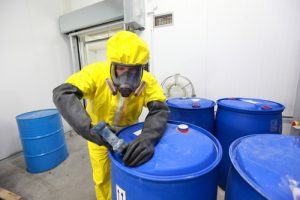Hazmat training requirements under the Pipeline and Hazardous Materials Safety Administration’s (PHMSA) regulations are nonspecific. But one thing is crystal clear: Employers are legally responsible for making sure hazmat employees are properly trained.
According to PHMSA regulations, hazmat training must ensure that: “… a hazmat employee has familiarity with the general provisions of this subchapter, is able to recognize and identify hazardous materials, has knowledge of specific requirements of this subchapter applicable to functions performed by the employee, and has knowledge of emergency response information, self-protection measures, and accident prevention methods and procedures.” Beyond this overall objective, however, there are relatively few explicit provisions.
So, What Should Training Cover?
Mainly, training must cover five specific areas.
- General awareness/familiarization training
- Function-specific training
- Safety training
- Security awareness training
- In-depth security training
The first four are mandatory for all hazmat employees. The last one is mandatory for employees whose employer is required to have a hazmat transportation security plan and who perform regulated functions related to the transportation of materials covered by the transportation security plan or who are responsible for implementing the security plan.
Employees must be tested on the material covered in training, although there is no requirement that testing be scored. In addition, employers must ensure that refresher training is conducted at specific intervals and that training records are kept.
How and by whom the training is conducted and the actual contents of training lessons are left to the hazmat employer. While those directions are intentionally nonspecific, the regulations explicitly state that it is the employer and the employer alone that is legally responsible for making sure that employees are provided with the knowledge and skills necessary to perform their hazmat job functions safely.
Tips for Employers
The following suggestions to help employers make the right choices in their training programs are gleaned from PHMSA’s publication, Guide to Developing a Hazmat Training Program.
-
- Make a plan. PHMSA suggests the plan include a statement of purpose and the benefits of thorough and regular employee training as appropriate to the job function(s), the company, and its resources. The plan should include specific directions on evaluating the effectiveness of training and directions for completing administrative tasks, such as recordkeeping and scheduling.
- Identify hazmat employees. According to PHMSA regulations, hazmat employees include those who:
- Determine the hazard class of a hazmat;
- Select hazmat packaging;
- Place warning signs, block wheels, and set brakes on tank cars placed for loading or unloading with closures open;
- Mark packages to indicate that they contain hazmats;
- Provide and maintain hazmat emergency response information;
- Provide international shippers with information on U.S. hazmat requirements;
- Segregate a hazmat package in a freight container or transport vehicle from incompatible cargo; or
- Load or unload hazmats for the purpose of transportation.
- Conduct a needs assessment before developing a training program. For example, determine the level of awareness hazmat employees have about hazmats and the regulations, as well as the level of training they’ve already had. Also, find out if the training employees have already received is adequate for the tasks they are now performing. If your company’s operations have changed since the last round of training, determine if new employee training has occurred to accommodate the changes.
- Select a training tool. PHMSA’s guidance for hazmat employee training lists four training delivery methods:
- Web-based
- Computer-based
- Classroom
- Hands-on/mentor training
Decisions on which of these, or which combination, is most appropriate will depend on many factors, including cost, suitability for the hazmat employee and the employee’s hazmat responsibilities, language proficiency, whether employees can be self-directed, and qualifications of the instructor.
- Evaluate the effectiveness of the training program. A training program is only as good as the results it produces. That means you should ask employees about how they benefited from the training and also observe whether training has been incorporated into their on-the-job performance.
- Assign a training manager. Responsibilities can include arranging for newly trained employees to be evaluated, determining additional training needs for incumbents, communicating the status of training to upper management, and maintaining training records in compliance with PHMSA regulations.
- Don’t stop with training. Develop a safety culture that encourages training as part of daily and typical tasks and operations. Attention to regulatory requirements, efficiency, and improved performance invariably begins with demonstrated commitment by top management followed by buy-in from all other levels of the company.

